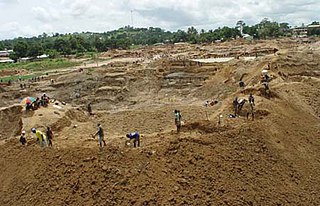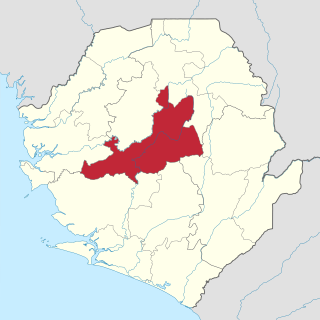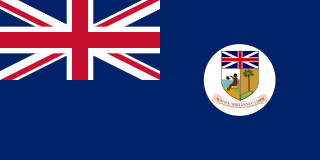External links
- Catalogue of the Selection Trust papers at the Archives Division of the London School of Economics.
- Documents and clippings about Consolidated African Selection Trust Ltd in the 20th Century Press Archives of the ZBW
| Industry | Mining |
|---|---|
| Founded | 1934 |
| Defunct | 1971 |
The Sierra Leone Selection Trust was formed in 1934 following an agreement between the government of British Sierra Leone and the Consolidated African Selection Trust Ltd (CAST). CAST was formed in 1924 and was part of a much larger mining finance house Selection Trust Ltd which had been founded in 1913 by Alfred Chester Beatty (an American mining magnate). Although the Oppenheimers (De Beers) invested in CAST and its subsidiaries from the 1920s and had boardroom representation, CAST was independent of the Oppenheimer empire. SLST corporation which had exclusive mineral mining rights in Sierra Leone beginning in 1935 was scheduled to last for 99 years. In 1955, the SLST abandoned mineral mining and settled on mining the Yengema and Tongo Fields. However, with the creation of the Sierra Leonean parastatal National Diamond Mining Company in 1971, the diamond company was effectively nationalized, ending the SLST in Sierra Leone.

The economy of Sierra Leone is $4.082 billion by gross domestic product as of 2018. Since the end of the Sierra Leone Civil War in 2002, the economy is gradually recovering with a gross domestic product growth rate between 4 and 7%. In 2008 it in PPP ranked between 147th by World Bank, and 153rd by CIA, largest in the world.

The De Beers Diamond Consortium is an international corporation that specializes in diamond mining, diamond exploitation, diamond retail, diamond trading and industrial diamond manufacturing sectors. The company is active in open-pit, large-scale alluvial and coastal mining. It operates in 35 countries and mining takes place in Botswana, Namibia, South Africa, Canada and Australia.

Blood diamonds are diamonds mined in a war zone and sold to finance an insurgency, an invading army's war efforts, terrorism, or a warlord's activity. The term is used to highlight the negative consequences of the diamond trade in certain areas, or to label an individual diamond as having come from such an area. Diamonds mined during the 20th–21st century civil wars in Angola, Ivory Coast, Sierra Leone, Liberia, Guinea, and Guinea-Bissau have been given the label. The term conflict resource refers to analogous situations involving other natural resources. Blood diamonds can also be smuggled by organized crime syndicates so that they could be sold on the black market.

Tonkolili District is a district in the Northern Province of Sierra Leone. Its capital and largest city is Magburaka. The other major towns include Masingbi, Yele, Mile 91, Bumbuna, Yonibana, Matotoka. Mathora, Magbass and Masanga. Tonkolili District is home to the largest sugar factory in Sierra Leone, and one of the largest sugar factories in West Africa, that is located in the town of Magbass. Tonkolili District had a population of 530,776. The district occupies a total area of 7,003 km2 (2,704 sq mi) and comprises eleven chiefdoms.
Vasile Frank Timiș is a Romanian-Australian businessman living in London, with interests in mining and oil extraction industries. The Sunday Times Rich List estimated his wealth at £162m (US$238m) as of April 2008, making him the 497th richest person in Britain. The Romanian magazine Capital reckoned Timiș to be the 9th richest Romanian, estimating his wealth at $290m as of 2006. In 2012 he became the richest Romanian with a net worth of £1.34 billion (US$2.13 billion). A BBC News investigation alleged that Timiș paid £35.20 in tax in 2017 despite living a life of luxury, and included a statement from the Tax Justice Network suggesting that Timiș be investigated for tax fraud.
Titanium mining in Africa has been beset by environmental problems due to the polluting nature of processing rutile, a principal titanium ore. Titanium production in Africa includes the following principal countries and companies.
SLST may refer to:
Tongo, also known as Tongoma, is a diamond mining town and the second largest city in Kenema District, located in the Eastern Province of Sierra Leone. Tongo is about twenty seven miles to Kenema. The population of the 60-sq.-mile city is 44,376.
There is a significant population of Lebanese people in Sierra Leone.
The mineral industry of Africa is the second-largest mineral industry in the world. Africa is the second largest continent, with 30.37 million square kilometre of land, which implies large quantities of resources. With a population of 1.4 billion living there. For many African countries, mineral exploration and production constitute significant parts of their economies and remain keys to economic growth. Africa is richly endowed with mineral reserves and ranks first in quantity of world reserves of bauxite, cobalt, industrial diamond, phosphate rock, platinum-group metals (PGM), vermiculite, and zirconium.

The mining industry of Sierra Leone accounted for 4.5 percent of the country's GDP in 2007 and minerals made up 79 percent of total export revenue with diamonds accounting for 46 percent of export revenue in 2008. The main minerals mined in Sierra Leone are diamonds, rutile, bauxite, gold, iron and limonite.
The Rhodesian Selection Trust (RST) was a mining Corporation which produced copper from the Copperbelt region of Northern Rhodesia, now Zambia.
Jean-Raymond Boulle, COR is a Monaco-based Mauritian businessman, the founder of four publicly traded companies with deposits of nickel, cobalt, copper, zinc, titanium and diamonds.
Charles Watson Boise was an American-born naturalised British mining engineer.

The Colony and Protectorate of Sierra Leone was the British colonial administration in Sierra Leone from 1808 to 1961, part of the British Empire from the abolitionism era until the decolonisation era. The Crown colony, which included the area surrounding Freetown, was established in 1808. The protectorate was established in 1896 and included the interior of what is today known as Sierra Leone.

Canada–Sierra Leone relations refer to bilateral relations between Canada and Sierra Leone. Ties were first established in 1961, when Sierra Leone gained its independence. Canada is represented in Sierra Leone through its High Commission in Accra, Ghana. Sierra Leone is represented in Canada through its embassy in Washington, D.C.
Selection Trust was a British mining finance house. It was started in 1913 by A. Chester Beatty, a mining engineer from the United States. After the end of the First World War, Beatty built up a substantial portfolio of mining interests, many of them in Africa, but others in Serbia and in Siberia. Initially the company began operations by sharing an office at Number One London Wall in the City of London with the consulting firm of Herbert Hoover, a fellow American mining engineer.
The Minorco SA was a mining company based in Luxembourg. It was set up by the South African Anglo American Corporation in 1987 to hold its non-African, non-diamond mining operations. Although Minorco was quoted on the Luxembourg Stock Exchange the majority of its shares were controlled by the Oppenheimer family directly and indirectly via Anglo American Corporation and its then sister company De Beers.
Alhaji Mohamed Bailor Barrie, simply referred to as Bailor Barrie or M.B. Barrie was a Sierra Leonean businessman, activist and philanthropist. He hailed from Sierra Leone's northern district of Koinadugu and was a member of the Fula ethnic group of which he later became a well known activist and leader. Barrie became prominent in Sierra Leone's post colonial economic environment in the 1970s as the first Fula to venture into the European-Lebanese dominated import business of motor vehicles. He became very successful in the booming diamond mining and trading industry in the 1970s and 1980s, which established him as one of Sierra Leone's most successful businessmen, even without a standard level of education. Then president of Sierra Leone Siaka Stevens was using Barrie's success to defend himself against critics attacking him for ignoring the country's crumbling educational sector, by claiming that one could be successful like Barrie without any standard level of education. Barrie died in a road accident in 1989 on his way from Kenema, in the eastern part of Sierra Leone.